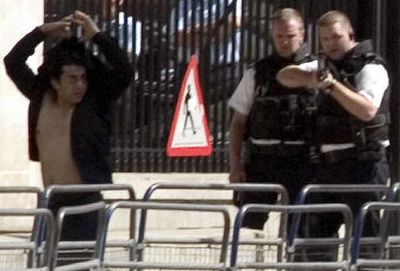Attacks sputter, shake Brits

LONDON – Four attacks, almost simultaneous, on three subway trains and a double-decker bus. No blood and not as sophisticated, but hauntingly, unnervingly similar to deadly explosions set off by four suicide bombers exactly two weeks before – and an inescapable message that life in London now means living with the threat of terror.
“We can’t minimize incidents such as this,” Prime Minister Tony Blair said. “They’re done to scare people, to frighten them and make them worried.”
That they did.
The explosive devices were either faulty or too small to cause bloodshed, and the only reported injury turned out to be an asthma attack. But Thursday’s lunch-hour blasts rattled a capital already on edge after the July 7 explosions, which killed 52 people plus four suicide bombers.
Police said two men were arrested. One was detained near Downing Street, site of the prime minister’s residence. The other, later released without charge, was picked up near Tottenham Court Road, close to the Warren Street subway station where one attack took place.
Authorities said it was too early to determine whether the attacks were carried out by the same organization as the July 7 blasts – or whether they were linked to al Qaeda.
But NBC News reported that British authorities told their U.S. counterparts that backpacks and explosives used Thursday were identical to those in the July 7 attacks. And the British Broadcasting Corp. reported “speculation” that the devices were so similar they may even have been part of the same batch.
“Clearly, the intention must have been to kill,” Police Commissioner Ian Blair told reporters. “You don’t do this with any other intention. And I think the important point is that the intention of the terrorists has not been fulfilled.”
Londoners fled the three Underground stations at midday, some sprinting barefoot after leaving their shoes behind in the scramble.
Witnesses on the Underground heard a pop like a bursting champagne cork. Others smelled an odor like burning rubber. At least one reported a minor explosion in a man’s backpack, and then the man muttering that something had gone wrong.
Bus passengers reported a bang on the upper level, where windows were blown out. But some witnesses said the blast wasn’t loud. Witnesses first saw the police running up the road, followed soon after by news cameramen lugging tripods.
The prime minister appealed for calm, and a Buckingham Palace garden party for 8,000 people, hosted by Queen Elizabeth II, went ahead.
But even among the famously stoic British, nerves were on edge.
“When I got home, my hands were shaking,” said 24-year-old Lisa Chilley, who uses the targeted Oval station. “I’m panicking like hell. It’s just too close to home.”
Firefighters and police with bomb-sniffing dogs sealed off city blocks and evacuated rows of restaurants, pubs and offices.
Britain’s Press Association news agency reported detectives were working on the belief that the bombs were not properly primed – which could help explain the limited damage.
Although authorities did not say how many devices exploded, Paul Beaver, an independent defense expert, said an official told him it appeared that two bombs detonated and two others did not. Detonators are often faulty on commercial and military explosives, he said.
“These attacks don’t look like they were a hallmark of any one group,” Beaver told the Associated Press. “They don’t fit into any clear patterns that we know of except they were timed.”
One of the greatest police fears is that an audacious attack will inspire similar attacks, said Rachel Bronson, director of Mideast Studies at the New York-based Council on Foreign Relations. “It’s all done to sow terror, and there’s nothing more terrifying than bombs followed by bombs,” she said.
Alarmingly, it appears the group was able to attack in the midst of an intense investigation of the previous bus and train bombings. Often such follow-up attacks are uncovered and thwarted, Bronson said.
“What is very worrisome, London intelligence, which is among the best in the world, was not only surprised two weeks ago, but they’re surprised by this,” she said.
Emergency teams were sent to the three Underground stations after the attacks, and the police commissioner said forensic evidence collected could provide a “significant break.”
In one closely watched development, an armed police unit entered University College hospital shortly after the blasts. Sky News TV reported that police were searching for a man with a blue shirt with wires protruding from his pocket. Officers asked employees to look for a black or South Asian man about 6-foot-2.
By late Thursday, the hospital said police had searched the facility but that three small rooms in an unoccupied part of the complex were cordoned off.
The attacks paralleled the July 7 blasts, which involved explosions at three Underground stations simultaneously starting at 8:50 a.m., followed about an hour later by a bomb going off on a bus. Those bombings took place in the center of London.
Thursday’s attacks were more spread out and occurred during the lunch hour – beginning about 12:38 p.m.
The bombs, which targeted trains near the Warren Street, Oval and Shepherd’s Bush stations, did not shut down the subway system, only three of its lines. The bus was hit while on Hackney Road in east London.
Near the bus explosion, firefighters and police, some with bomb-sniffing dogs, sealed off a city block of restaurants, shops and apartments. Residents peered through the curtains of upper floor windows, speaking on cell phones.
For some commuters, the new closures would hardly matter. Fethi Brandou, a 36-year-old gardener, said he’d be reluctant to take the Underground again – no matter what.
“I wouldn’t take the Tube now,” he said. “I’ll buy a bicycle or walk.”